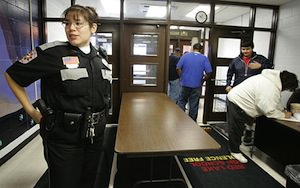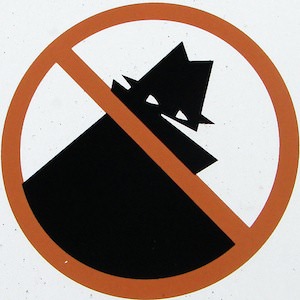How Schools Are Becoming Prisons
The school-to-prison pipeline is under fire for its over-the-top thuggishness, but officials are responding to massacres like the one in Newtown by pushing to make campuses more prison like. Bay Area journalist and author Annette Fuentes discusses the phenomenon she documented in her book "Lockdown High: When the Schoolhouse Becomes a Jailhouse."The school-to-prison pipeline is under fire for its over-the-top thuggishness, but officials are responding to massacres like the one in Newtown by pushing to make campuses more jail like.
By Chase Madar
The school-to-prison pipeline is under fire as its over-the-top thuggishness — exemplified recently in New York by the police handcuffing of a 7-year-old under the false suspicion he took $5 from a classmate — makes headlines more and more often. But the initial government response to tragedies like the Newtown school massacre has not been meaningful gun control. Instead, officials are pushing to make campuses more prison like: more armed police personnel, more metal detectors and more surveillance technology. I recently discussed the matter with Annette Fuentes, a Bay Area journalist and the author of “Lockdown High: When the Schoolhouse Becomes a Jailhouse,” the single best study of the overcriminalization of American schoolchildren.
Chase Madar: What is the school-to-prison pipeline?
Annette Fuentes: Education researchers and youth advocates began using that provocative and descriptive term more than a decade ago to describe the process in which the failures of public schools to educate so many kids puts them at risk of getting sucked into the juvenile criminal justice system. Today, it encompasses increased policing in schools, which means more arrests and the direct flow of youth into detention centers, as well as the epidemic of suspensions for minor violations of school codes that may be treated in a court setting.
In “Lockdown High,” I describe a two-way flow of the pipeline, with features of the criminal justice system, especially prisons, being adopted by schools. Surveillance cameras, metal detectors, even biometric ID systems that were originally developed for prisons are now commonplace in schools. And some of this technology, I discovered, has been devised with government funding at the Department of Justice in the name of “school safety.”
Madar: What do you expect will happen to school security in the U.S. after the massacre at Sandy Hook Elementary last December? Both the National Rifle Association and liberal Democratic senators like Barbara Boxer have requested that more armed guards be put in schools. Is this likely to happen?
Fuentes: After every high-profile, headline-grabbing mass shooting, like Columbine in 1999 and now the Sandy Hook tragedy, there is a predictable and reflexive public reaction in favor of beefing up school security. More armed police. More cameras, etc. Parents rightly want to believe their kids will come home from school safe and sound, and they pressure school administrators and politicians to do something concrete and immediate to guarantee that. But in truth, if someone wants to harm a large number of people — kids, theatergoers, shopping mall customers — it is almost impossible to stop them given the abundance of semi-automatic weapons and large capacity magazines that make them killing machines. Sandy Hook Elementary had locked doors and an intercom system that required visitors to be buzzed in, but the shooter blasted his way.
It is instructive to note that after the Columbine assault, in which 13 victims and the two assailants died, the school community made a conscious decision not to install metal detectors at school doors. The principal told me that they didn’t want to turn the school into “a fortress.” In fact, the school added a couple more cameras in the hallways and hired a couple of older men to act as hall monitors — unarmed. They stuck with the same one local policeman assigned to the school.
The NRA’s proposal to put an armed guard in every school is what you’d expect from the gun industry’s lobby. Boxer’s proposal is proof that the “school violence” issue is something everyone can get behind — a real unifying, bipartisan issue! Luckily, there just isn’t the money to pay for such harebrained and useless schemes, and they will fade soon enough. But what has been heartening has been the widespread focus on and debate over gun control that really dominated the news and the narrative post-Sandy Hook. That was not the case after similar mass shootings.Madar: Some American high schools can be chaotic, and plainly need more order and self-discipline if the kids are going to learn anything. Are there viable alternatives to zero-tolerance discipline, police personnel and metal detectors to make these schools safe and orderly?
Fuentes: Schools that are chaotic and have disciplinary problems are schools that are poorly managed and have administrative problems. Don’t blame the kids. Researchers Matthew Mayer and Peter Leone found that schools with more police and security hardware also had more disorder and disciplinary problems. The students didn’t feel safe; the environment encouraged a sense of insecurity and students responded accordingly.
There are models all over the country of schools that shed zero tolerance discipline and embraced approaches to school safety and discipline that are appropriate for their overriding mission: education! Conflict resolution, peer mediation, restorative justice. These are now proven programs in the public school setting. It’s no secret what works. It’s just that the public school system — from federal through state and local levels — do not support those alternatives with funding or policy. Yet.
Madar: You mention in your book the many ways for private companies to make money from the school-to-prison pipeline. To what degree is the pursuit of profit driving the way many schools are becoming more jailhouse like?
Fuentes: The profit motive is certainly one reason harsh disciplinary and security practices are so firmly rooted in our schools. I found examples of local school officials and employees angling to install some really zany security and student tracking systems, which they just so happened to have financial interests in. The school police sector is another large interest that promotes the view of schools as dangerous and requiring a criminal justice approach — not an educational one. I’d say that overall, the public’s belief in public schools as dangerous, scary, creates the opening for what I call the profiteers to exploit that fear.
Madar: What do you think could reverse the trend of American schools becoming more and more prison like?
Fuentes: The movement is under way to expel zero tolerance and dismantle the school-to-prison pipeline led by a coalition of legal, educational and youth groups. They are calling on Congress to revise the federal education law — known as No Child Left Behind — to adopt a new paradigm of school discipline known as positive behavior supports. Los Angeles’ schools implemented that model several years ago. I think the pendulum is swinging in the other direction, toward less harsh discipline. But it will take the concerted efforts of the friends of public education to make the change stick.
Chase Madar (@ChMadar) is an attorney in New York and the author of “The Passion of Bradley Manning: The Story Behind the Wikileaks Whistleblower” as well as policy research on alternatives to the school-to-prison pipeline.
Your support matters…Independent journalism is under threat and overshadowed by heavily funded mainstream media.
You can help level the playing field. Become a member.
Your tax-deductible contribution keeps us digging beneath the headlines to give you thought-provoking, investigative reporting and analysis that unearths what's really happening- without compromise.
Give today to support our courageous, independent journalists.





You need to be a supporter to comment.
There are currently no responses to this article.
Be the first to respond.